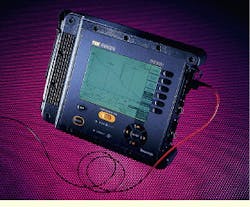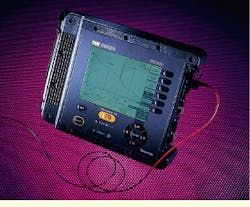Arlyn S. Powell, Jr.
If you listened to the opinions of cabling installers and test equipment manufacturers, you might conclude that Goldilocks would have liked the mini-optical time-domain reflectometer. This is because the mainframe OTDR is too big, bulky and expensive; and the optical fault locator is too small and limited in capability; but the mini-OTDR is just right.
Fiber-optic test equipment manufacturers first offered expensive, full-featured optical time-domain reflectometers to telephone companies more than a decade ago. These devices provided much information about installed fiber, but they were too big and bulky to use conveniently in the field, and their high price ensured only the largest companies would buy them. When optical fiber began to be used in premises applications, vendors saw an opportunity to introduce an inexpensive device that would show the location and size of a fiber fault, but not all the other diagnostic information that required the expensive optics and electronics of the mainframe.
It soon became apparent, however, that cabling contractors and network managers needed more than the simple fault-finding capability of the optical fault locator. Specifically, they needed the OTDR traces that characterized optical-fiber runs, which would enable the documentation and certification of a cable plant. And so the mini-OTDR was born.
The mini-OTDR has many uses in installing and maintaining building and campus wiring. "The main use is to locate breaks in cable," says Perry Sweat, who is in charge of fiber-optic purchasing at installation contractor Key Four Inc. (Tucker, GA), "but you can also test for signal loss in a cable. And you can measure the distance to a splice or connector, and the loss at that location."
He adds, however, "We don`t use mini-OTDRs that much. The only time we`re likely to use one is when a customer has a cable that doesn`t work, and we need to troubleshoot it. If we`ve tried everything else, and the cable is still showing a loss, we`d shoot it with a mini-OTDR to locate a twist, bend, break or cut. The mini-OTDR shows how far down the cable the problem is located."
Often, simple solution
Sometimes the problem is simple to solve. It may only be a matter of unkinking or untensioning the cable, or you may solve the problem by loosening overtightened tie wraps. In other cases, the outer fibers in a 6-fiber cable may be abraded during pulling, so you switch to two spare fibers.
Phil Baker, a network engineer at BCI Communication Inc. (Tulsa, OK), has a different view of this equipment. "Normally we use them for outside work," he says. "If you`re looking for a problem in a campus plant, then a fault locator might be all that`s required. But if the fault is a break and you splice it, you really need a mini-OTDR to make sure the splice is within specification.
"We also use them inside when the owner of a facility specifies an OTDR test and a printout or diskette. It usually takes either an OTDR test or a power meter test to satisfy the spec."
When Baker discusses mini-OTDRs, he is concerned about price, portability and the reputation of the manufacturer. "They`re also easy to use," he adds, "which is a big advantage over the older OTDRs. You had to be a pretty sharp technician to calibrate them, but with the newer ones, you hook up your fiber, the device goes through a self-test, and you`re ready to go. It gives you menu-driven parameters you can test."
Baker concludes, however, "The technology is moving so fast that I don`t want to be strapped down with one device. They rent for approximately $125 per day. That`s the most economical way for a small contractor."
Vendor approaches varied
Manufacturers have not been slow to jump on the mini-OTDR bandwagon. The number of vendors offering a mini in their product lines has doubled in the past year--and now approaches a dozen. The main reason for this, according to Todd Baker, product manager of handheld optical products at Tektronix Inc. (Beaverton, OR), is the growth of the networking market. "You`re going to see a lot more installers using mini-OTDRs to do premises cabling," he adds.
Mainframes are heavy and not very portable and require AC power, but the big problem has been price. Installers have solved the problem by renting equipment, but Baker points out that you can now purchase a mini for what it would cost to rent a mainframe for a few months. "And the mini-OTDR is coming closer and closer to the mainframe as far as performance goes," he says. "What you see is a trend toward increased capabilities and lower prices."
Mainframes still have a few advantages over minis. They have shorter dead zones, process data faster and have built-in printers. "But," Baker asks, "is that worth paying three times the price? Most people will sacrifice a little performance to gain that cost advantage."
The Tektronix mini-OTDR has several features that Baker claims are important. One is a 3.5-inch floppy disk drive that lets the technician transfer information to a personal computer for analysis and printing. The disk drive also permits field upgrades to the device itself, and the user interface has been improved. "Everyone wants something different from an OTDR, so we`ve made our interface customizable by the user," Baker says. "It`s like a spreadsheet: If something`s unimportant, they can turn it off; if something`s more important, they can change the order of parameters displayed, making it first."
Intellitrace, however, is the most recent product innovation offered by Tektronix. "We`ve found that contractors don`t have much time for training," Baker says. "They want to be able to just pick up a tool and use it. So we`ve made an intelligent box." For example, with many OTDRs, the operator must change pulsewidth to move from viewing close-in events to more distant ones. Intellitrace, a combination of hardware and software modifications, automatically increases the pulsewidth and displays a single, complete trace with the press of one button. "Otherwise," he adds, "you have to shoot each fiber twice, doubling your documentation and confusing people, because everything isn`t shown in the same trace."
The multitest concept
Another approach to adding value to the mini-OTDR is to increase the number of tasks it can perform. This is the approach taken by Siecor Corp. (Hickory, NC), according to Mark Conner, product manager. "We found that people were not only interested in having an OTDR in the box, but they also wanted other features such as visual fault location and power metering. That`s where the multitest concept was born."
Siecor prefers to call its device a compact OTDR rather than a mini, because the prefix "mini" has the connotation of "limited" for some users. The compact OTDR handles both singlemode and multimode fiber, can be individually configured at the factory to perform a wide range of functions and can be upgraded later to perform others as the need arises--and all at a price that is lower than Siecor`s mainframe OTDRs.
In addition, it offers a simplified user interface that features an autotest function "where you have the machine set up the test parameters, look for events and give you a table and a trace," Conner says. The front panel features a built-in mouse to manipulate Windows-style software. "You can point and click or drag the marker," he adds. "You can select a menu, choose a couple of options and say `go.` The device performs a dual-wavelength test and tells you when to put the next fiber in, and that`s all you have to do until the job`s done. Then you have a floppy disk full of OTDR traces. The device is really friendly and useful to the field craftsperson."
Anritsu Wiltron Sales Co. (Fairfield, NJ) thought about adding extra functions to its mini-OTDR, according to Mark Jensen, product marketing engineer, but instead decided on a modular approach. "In end-to-end testing," he says, "you`ve got a light source at one end of the fiber and a power meter at the other. If you use built-ins, you have to buy two $15,000 mini-OTDRs to do the most basic kind of optical test. You can get a handheld power meter and light source for less than $1000 if you need them, but most people don`t. They already have them."
Anritsu`s basic unit is the operator interface mainframe module. It holds the microprocessor, a backlit screen, keyboard, floppy-disk drive and input/output ports. Two separate units attach to the operator interface--a battery pack and an optical unit. "It takes either nickel-cadmium batteries or alkaline batteries," Jensen adds. "It`s advantageous to have the capability to put in C cells from the convenience store if you`re working away from AC power for a long time."
The optical units come in six configurations--two multimode and four singlemode. "For multimode it comes in either 850 nanometers or 850/1300 nm," Jensen says. "Contractors love the dual-wavelength module, because it`s convenient for them to push a button to switch wavelengths." The basic singlemode modules come in 1300- and 1310/1550-nm formats; there are also high-dynamic-range modules in the same singlemode wavelength formats.
Retraining unnecessary
The modular approach works well in an area where technology rapidly changes. A company can purchase an operator interface and train its technicians in the use of the device. "The operator interface stays constant, so you don`t have to retrain. As we make technological advances in the optics, you can buy new plug-in modules for just a fraction of the original purchase price," Jensen says.
The Anritsu Wiltron mini-OTDR is also modular in its approach to software. "As new features come out," Jensen concludes, "we can upgrade our operating system with a standard PCM/CIA card or a 3.5-inch floppy drive. It takes approximately three minutes." The upgrade cards can be sent out to equipment owners, but the company prefers to have the devices sent in to maintain software version control, and so they can be cleaned and checked at the same time.
The Tekranger mini-OTDR from Tektronix Inc. has an optical disk drive and features both singlemode and multimode test capability in one instrument.

